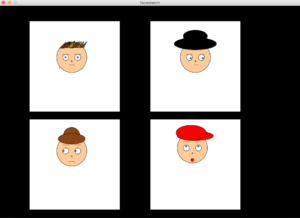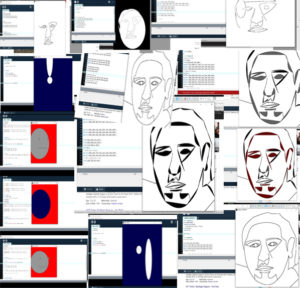
Category: Uncategorized
Self-portrait

Collision detection by Mike Bostock
http://bl.ocks.org/mbostock/3231298
Face

Face Sketch

ActionScript
ActionScript started as an object-oriented language for Macromedia’s Flash authoring tool, now developed by Adobe Systems as Adobe Flash. The first three versions of the Flash authoring tool provided limited interactivity features. Early Flash developers could attach a simple command, called an “action”, to a button or a frame. The set of actions was basic navigation controls, with commands such as “play”, “stop”, “getURL”, and “gotoAndPlay”. With the release of Flash 4 in 1999, this simple set of actions became a small scripting language. New capabilities introduced for Flash 4 included variables, expressions, operators, if statements, and loops. Although referred to internally as “ActionScript”, the Flash 4 user manual and marketing documents continued to use the term “actions” to describe this set of commands. ActionScript was initially designed for controlling simple 2D vector animations made in Adobe Flash (formerly Macromedia Flash). Initially focused on animation, early versions of Flash content offered few interactivity features and thus had very limited scripting capability. Later versions added functionality allowing for the creation of Web-based games and rich Internet applications with streaming media (such as video and audio). Today, ActionScript is suitable for mobile development through Adobe AIR, use in some database applications, and in basic robotics, as with the Make Controller Kit.
Self-Portrait

Processing

SEQUEL
SQL (pronounced “ess-que-el”) stands for Structured Query Language. SQL is used to communicate with a database. According to ANSI (American National Standards Institute), it is the standard language for relational database management systems.
Chamberlin is probably best known as inventor of SQL (Structured Query Language), the world’s most widely used database language. Developed in by Chamberlin and Raymond Boyce, SQL was the first commercially successful language for relational databases. SQL (Structured Query Language) is a standard interactive and programming language for getting information from and updating a database. Although SQL is both an ANSI and an ISO standard, many database products support SQL with proprietary extensions to the standard language.
This language was developed at IBM by Donald D. Chamberlain in the decade of the 70’s. Initially was called SEQUEL but the name had to be change caused it was the trademark for an UK aircraft company. Donald Chamberlin and Raymond Boyce started developing this language to manipulate and retrieve data already store in IBM database system, called System R, which a group of IBM in San Jose Research Laboratory had developed before. They initially planned to sell SEQUEL to CIA and the NAVY. This language was commercial in 1981.
The Elements of SQL are clauses, expressions (scalar values, tables, columns), predicates (based on the three value logic 3VL;True, false, unknow), statements and queries (the initial and main function; retrieve data based on specific criteria).
Self_Portrait
 I have a few questions before I move on any further with this, but this is what I’ve got so far.
I have a few questions before I move on any further with this, but this is what I’ve got so far.